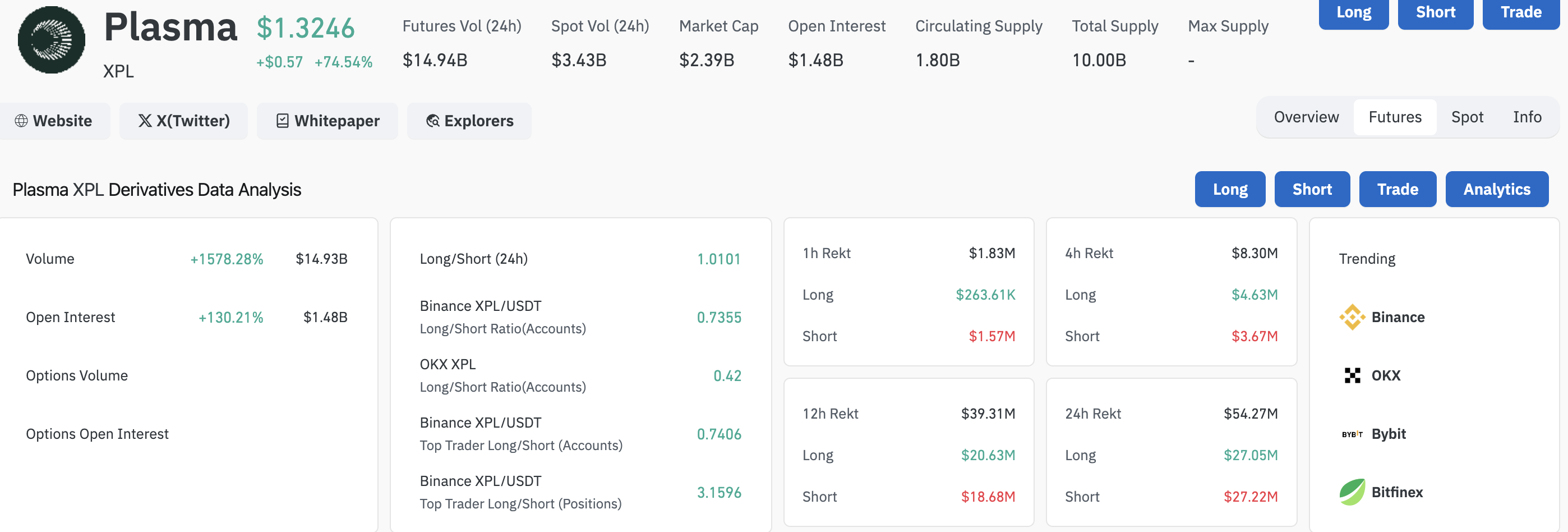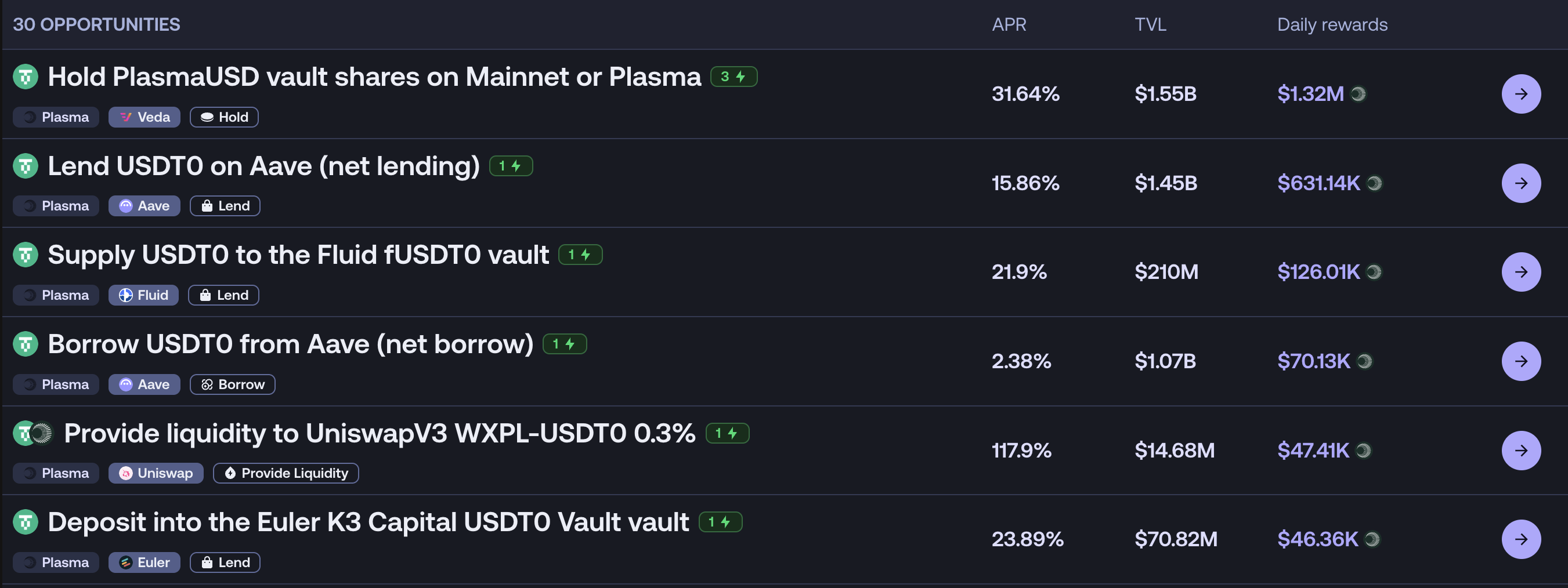Author: Nancy, PANews
"The hot trend must die" is almost an industry consensus, but Plasma has staged a textbook-level debut, achieving a "grand slam" with its exchange launch while its "big airdrop" strategy targeting presales and the community has further heightened the excitement.
Luxurious Airdrop Marketing Effect Maximized, FDV Soars to $10 Billion
With a generous airdrop strategy, Plasma sparked market frenzy on its first day of launch, effectively dispelling previous negative rumors about the team.
On the evening of September 25, the stablecoin public chain Plasma officially launched its mainnet and introduced its native token XPL, with an initial circulation ratio of 18%. Subsequently, major exchanges such as Binance, OKX, and Upbit almost simultaneously announced the listing of XPL, instantly igniting market enthusiasm.
According to CoinGecko, after its launch, the price of XPL surged to $1.47, with FDV approaching $12 billion. Data from Coinglass shows that its futures trading volume skyrocketed to $14.93 billion in a short time, with a daily increase of 1578%, and open interest quickly climbed to $1.48 billion. In the Binance XPL/USDT contract, the long-short ratio among top traders is about 3.1, indicating that large funds generally lean towards bullish positions. For example, the largest XPL long position on Hyperliquid has already realized over $10 million in profit.

In fact, backed by the Tether halo, Plasma was already being frantically snapped up by whales during its previous public sale, even experiencing oversubscription. According to Dune data, Plasma attracted approximately $1.6 billion in funding across two rounds of deposits, with nearly 5,000 participants. The average deposits for the two rounds were about $450,000 and $283,000, respectively. Moreover, Plasma previously held a $1 billion deposit airdrop event in collaboration with Binance, which also sold out instantly.
These large buyers who participated in the presale received substantial rewards. According to Lookonchain monitoring, whale @RegbilTrades participated in the XPL public sale, spending $571,800 to buy 11.44 million XPL at a price of $0.05, with profits exceeding $11 million, yielding a return of 19 times; whale 0x790c previously deposited 50 million USDT into Plasma, obtaining a public sale quota of $2.7 million, and purchased 54.09 million XPL at an average price of $0.05, currently realizing profits exceeding $47.7 million. Even those participating through Binance channels, according to @ai_9684xtpa's analysis, could obtain 11,489 XPL by filling a single account with $100,000, with maximum profits exceeding $16,600. Additionally, PANews has compiled airdrop data and will comprehensively review Plasma's airdrop data in subsequent articles.
Even more surprisingly, Plasma also airdropped "luxurious pig's trotter rice." It is reported that Plasma allocated an additional 25 million tokens to all pre-stored users, which will be evenly distributed among all depositors. This means that regardless of whether one deposits $1 or $10,000, they will receive an additional 9,304 XPL as a reward, with a maximum value exceeding $13,000. This move directly won the favor of retail participants and maximized the marketing effect.
Mining Incentives Drive Stablecoin Ecosystem Layout, Will Compete Head-On with TRON?
Undeniably, Plasma played a beautiful hand right from the start of its mainnet launch. After successfully introducing over $2 billion in liquidity through multiple rounds of deposits, Plasma is rapidly leveraging a series of airdrop-style incentive activities to boost ecosystem enthusiasm.
On the exchange side, multiple platforms have simultaneously launched XPL mining, such as OKX with a prize pool of 8.8 million tokens, Gate with 3 million tokens, and Bitget offering 2.2 million tokens, among others. Meanwhile, Plasma has partnered with over 100 DeFi projects, including Aave, Ethena, Fluid, and Euler. According to Merkl page data, XPL mining yields generally range from 10% to 40%, with TVL varying from millions to hundreds of millions of dollars. The official Vault is particularly outstanding, currently boasting a deposit scale exceeding $1.5 billion, with an annualized yield (APY) as high as 31.64%.

Of course, to reduce liquidity management risks and strengthen user lock-up willingness, Plasma has chosen a gradual funding injection and incentive subsidy strategy. According to its DeFi head River, when the Plasma mainnet Beta launches, the team will bridge $1 billion USDT from the Ethereum mainnet and gradually inject it into Aave. However, to avoid market volatility or utilization imbalance caused by a sudden influx of large funds, Plasma has opted to inject the funds in batches over five days. During this period, users who deposit funds into the Veda vault can receive additional XPL rewards; however, if they choose to withdraw during the stabilization period, the funds will take 48 hours to arrive and they will lose all earnings during that period.
As a new L1 public chain, in addition to building on-chain ecosystem competitiveness, Plasma is also strategically focusing on emerging markets with high demand for stablecoins, such as Southeast Asia, Turkey, and South America, with selling points including lower usage thresholds, customizable gas tokens, zero gas transactions, and privacy features, thus being seen as a direct challenge to TRON.
Moreover, in the global payment scene, Plasma's ambitions go even further. Recently, Plasma announced that it will launch a new type of digital banking service called Plasma One after the mainnet Beta version goes live. This prepaid credit card will use the Plasma blockchain as a payment channel and will be issued by Rain, the company behind products like the Avalanche Card, aiming to enable everyone around the world to save, spend, and earn in USD within a single application without permission. Users can earn while they spend, for example, by directly paying from their stablecoin balance while earning over 10% in returns. Using any Plasma One card (physical or virtual) for spending can earn up to 4% cash back. Plasma states that the reason for building Plasma One is to unlock global access to USD and hopes to create technology based on its own infrastructure.
However, what truly determines whether Plasma can go further is not just the current high subsidies under the TVL and the halo effect of Tether, but whether it can establish a long-term stable user base in emerging markets, find a real landing path in practical payment scenarios, and withstand regulatory scrutiny.
免责声明:本文章仅代表作者个人观点,不代表本平台的立场和观点。本文章仅供信息分享,不构成对任何人的任何投资建议。用户与作者之间的任何争议,与本平台无关。如网页中刊载的文章或图片涉及侵权,请提供相关的权利证明和身份证明发送邮件到support@aicoin.com,本平台相关工作人员将会进行核查。



